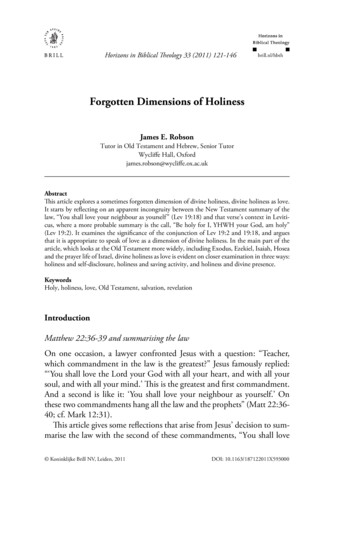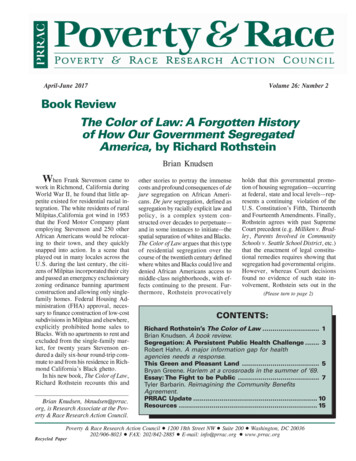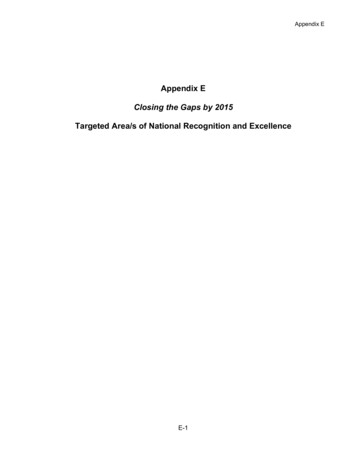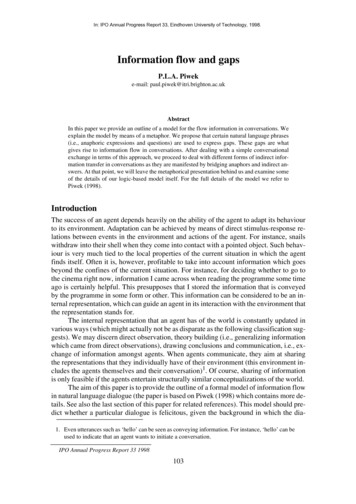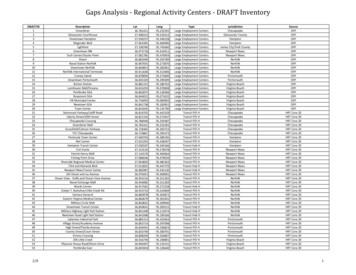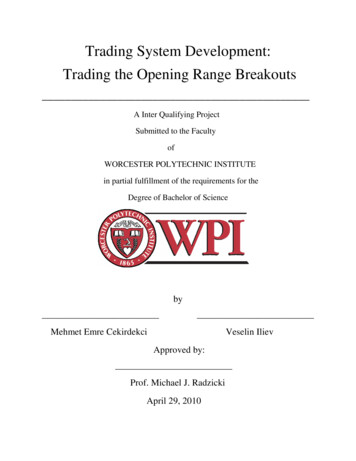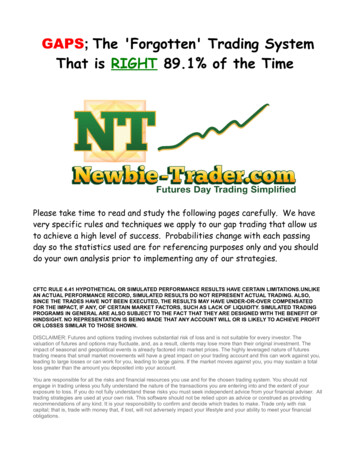
Transcription
GAPS; The 'Forgotten' Trading SystemThat is RIGHT 89.1% of the TimePlease take time to read and study the following pages carefully. We havevery specific rules and techniques we apply to our gap trading that allow usto achieve a high level of success. Probabilities change with each passingday so the statistics used are for referencing purposes only and you shoulddo your own analysis prior to implementing any of our strategies.CFTC RULE 4.41 HYPOTHETICAL OR SIMULATED PERFORMANCE RESULTS HAVE CERTAIN LIMITATIONS.UNLIKEAN ACTUAL PERFORMANCE RECORD, SIMULATED RESULTS DO NOT REPRESENT ACTUAL TRADING. ALSO,SINCE THE TRADES HAVE NOT BEEN EXECUTED, THE RESULTS MAY HAVE UNDER-OR-OVER COMPENSATEDFOR THE IMPACT, IF ANY, OF CERTAIN MARKET FACTORS, SUCH AS LACK OF LIQUIDITY. SIMULATED TRADINGPROGRAMS IN GENERAL ARE ALSO SUBJECT TO THE FACT THAT THEY ARE DESIGNED WITH THE BENEFIT OFHINDSIGHT. NO REPRESENTATION IS BEING MADE THAT ANY ACCOUNT WILL OR IS LIKELY TO ACHIEVE PROFITOR LOSSES SIMILAR TO THOSE SHOWN.DISCLAIMER: Futures and options trading involves substantial risk of loss and is not suitable for every investor. Thevaluation of futures and options may fluctuate, and, as a result, clients may lose more than their original investment. Theimpact of seasonal and geopolitical events is already factored into market prices. The highly leveraged nature of futurestrading means that small market movements will have a great impact on your trading account and this can work against you,leading to large losses or can work for you, leading to large gains. If the market moves against you, you may sustain a totalloss greater than the amount you deposited into your account.You are responsible for all the risks and financial resources you use and for the chosen trading system. You should notengage in trading unless you fully understand the nature of the transactions you are entering into and the extent of yourexposure to loss. If you do not fully understand these risks you must seek independent advice from your financial adviser. Alltrading strategies are used at your own risk. This software should not be relied upon as advice or construed as providingrecommendations of any kind. It is your responsibility to confirm and decide which trades to make. Trade only with riskcapital; that is, trade with money that, if lost, will not adversely impact your lifestyle and your ability to meet your financialobligations.
WHAT IS A GAPA break between prices on a chart that occurs when the price of acommodity or stock makes a sharp move up or down with no tradingoccurring in between. Gaps can be created by factors such as regularbuying or selling pressure, earnings announcements, or any other type ofnews release.THE OPENING GAPDue to the fact that the ES trades almost 24 hours a day on the GLOBEXthere are several days when price opens up at a different levels than whereit closed during the previous day. We call this difference the Opening Gap.
The ES (S&P 500 Futures) Gap usually fills 1/2 of its Gap within the firsthour of trading unless there is a strong trend break away gap that formsduring the overnight session. As Newbie-Traders in our Live Trading Roomat our sister site, EminiJunkie.com we look for a minimum of 1/2 the Gap tobe filled on a regular basis and note this price level as one of our key levelsto monitor during the trading day. One important note, we measure theclose, for our 1/2 Gap measurement, from the 4PM futures close.Here is a picture of a weeks worth of price action on a 60 Min chartshowing both the 4PM and 4:15PM EST ES futures close, the 9:30AM ESTOpen, and the 1/2 Gap as measured from the 4PM EST close.Click HERE to See Full Size Image.Click HERE to See a Short Video.
GAP ZONE PROBABILITIESWhere the next day opens, as compared to the previous day's close, givesus some key ideas on the probability for a gap fill. For instance if the openis within the previous days candle body regardless of direction you havealmost a 75% chance of the gap closing. Following a down day, you havealmost an 85% chance of the gap closing if you open between the close andlow of the previous day. Conversely, following an up day, you have almostan 85% chance of the gap closing if you open between the close and high ofthe previous day.Outside of the above mentioned zones the gap fill falls off to less than a65% fill rate. For our trading we like to concentrate on probabilitiesgreater than a 75% success rate, so we will ignore the other areas for now.
HIGH PROBABILITY GAP RANGEWe calculate our high probability gap range by looking at the previous daysrange and the previous five days (trading hours only) average true range.We take both those numbers and multiply by 40%. Which ever number issmaller is the number we use. We take the resulting value and we add it tothe higher of the 4pm or 4:15pm close and subtract it from the lower ofthe 4pm or 4:15pm close. The difference between the two numbers is ourhigh probability range.Example:High of Day 1806.75Low of Day 1798.50Yesterday’s Range 8.25 ; 40% 3.30 pts5 Day ATR 13.00 ; 40% 5.20 pts4PM Close 1801.504:15PM Close 1802.25High Probability Gap Range 1802.25 3.25 1805.501801.50 – 3.25 1798.25When we open within the high probability gap range we have over an 85%chance of filling the gap.USING THE PROBABILITIESWhen the open is within both the 85% Gap Zone and the 85% HighProbability Gap Range we have over an 89.1% chance that the closer of the4PM or 4:15PM EST Gap will fill and over a 94% chance of filling the 1/2Gap. Using this information alone will give you all the edge you need to beconsistent in trading the opening gap. However, in the next section we willgo over a few techniques for entry.
TRADING THE GAPTrading the 1/2 Gap is a high probability trade that we look to playeveryday in our Live Trading Room. Watch the gap in relation to the pivotlevels of R1 and S1. If the gap is above R1 or below S1 there is less chancein the gap filling that same day.Minimum Distance. You need a minimum of 1 point profit target to tradethe 1/2 Gap and 2 points profit target to trade the full gap. With such ahigh probability to close, you can use an inverted reward to risk propositionand still have a profitable strategy. Using no stop at all is notrecommended, but the last time we did a statistical analysis it was a breakeven trade without using any entry probability filters. so using our entryfilter techniques (Zones and Ranges discussed earlier) alone would suggest awinning system without a stop loss order. We suggest using a 5 point stoploss maximum if you are simply buying or selling at the open depending ontrading towards your Gap fill direction.If you were to win 1 point 19 times out of 20 (95%) you would haveapproximately 14 net points after taking 1; 5 point loss. Taking 2 pointsprofit 17 times out of 20 (85%) you would have approximately 19 net pointsafter taking 3; 5 point losses.Although trading on the open as described above would allow you to bebetter than 95% of all future traders, who do not have a daily trading plan,and consistently lose, we feel you can be even more profitable.Please click HERE for more information on the Newbie-Trader.com UltimateDelta Indicator. The NTDeltaCross is a perfect entry trigger tocompliment your Gap trading, always keeping you on the right side of themarket. Allowing you to operate with a much tighter stop, improving yourexpectancy ratio and overall trading performance.Thanks – Matt Brown
GAPS; The 'Forgotten' Trading System That is RIGHT 89.1% of the Time Please take time to read and study the following pages carefully. We have very specific rules and techniques we apply to our gap trading that allow us to achieve a high level of success. Probabilities change with each passing day so the statistics used are for referencing purposes only and you should do your own analysis .
